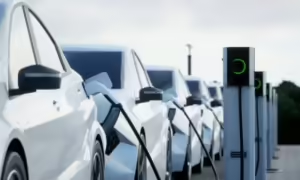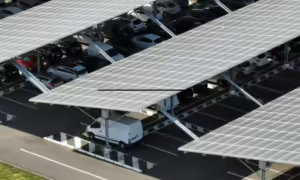The concept of agrivoltaics, also known as solar sharing, refers to the co-developing of the same area of land for both solar photovoltaic power as well as for agriculture. With this unique strategy, crop cultivation and the generation of renewable energy are integrated for the mutual benefit of both sides. Agrivoltaics is a sustainable path to food as well as green energy solutions for agriculture.
What is Agrivoltaics?
Agrivoltaics involves installing solar panels in agricultural fields in such a way that allows crops to still be grown underneath them. The concept is to harness solar energy in the contrary empty area between crop rows. As a result, more land is used, which promotes both continuous cultivation and sources of clean energy.
Some key advantages of agrivoltaics include:
- Dual use of land for both solar energy and agriculture.
- Increased revenue generation from the same plot of land.
- Lowered risk for farmers by diversifying income.
- Reduced water usage due to shading from solar panels.
- Lower operating temperatures for solar panels due to cooling from crops underneath.
Agrivoltaics is also sometimes referred to as solar sharing or co-location projects. The basic concept involves raising the solar panels off the ground and allowing crops to be grown in the empty spaces between and underneath the panels.
How Does Agrivoltaics Work?
There are a few different ways that agrivoltaics projects can be designed:
- Elevated solar panels – Solar panels are installed on elevated structures so that crops can be grown underneath. The panels provide partial shade to the crops below.
- Crop selection– Crops that require less sunlight, such as shade tolerant vegetables and herbs, are selected to be compatible with the shaded conditions.
- Bifacial solar panels– Special bifacial solar panels that can generate electricity from both sides are used. This allows crops on either side of the panels to receive sunlight.
- Solar tracking– The solar arrays use tracking technology to move and follow the sun during the day. This provides optimized sunlight exposure for the crops.
- Grazing livestock– Solar installations can incorporate grazing pasture land allowing livestock production as well. Animals can graze the grass below and between solar panel rows.
The optimal agrivoltaics design minimizes shading of crops while maximizing solar energy production. Careful configuration is required based on the crops, climate conditions, and solar technology used.
Primary Benefits of Agriculture Solar System
There are a number of potential benefits that can be realized by using a combined agrivoltaics approach:
Increased Land Use Efficiency
By using the same land area for both solar and agriculture, overall land use efficiency is improved. Solar panels can generate clean renewable power while crops are simultaneously grown on the same footprint of land.
Diversified Revenue Streams
Solar energy production allows farmers to increase their income while retaining agricultural output. This provides a more diversified income on the same plot of land reducing financial risk.
Optimal Use of Prime Farmland
High value prime farmland ideal for agriculture does not need to be sacrificed solely for solar development. Agricultural land is protected by the multiple applications frameworks, which also satisfies the demand for green energy.
Lower Solar Panel Operating Temperatures
The cooling effects provided by crops planted around and under solar arrays helps lower operating temperatures for the solar panels. The output of energy from solar cells may rise as a result.
Reduced Crop Water Usage
Partial shading from solar panels can reduce evapotranspiration lowering the water needs of crops. Reduction on cost of water usage results from this.
Increased Power Grid Resiliency
Distributed agrivoltaics systems feed into local power grids providing decentralized renewable energy sources and improved electricity resiliency.
Grazing Opportunities for Livestock
Solar installations can incorporate grazing sheep and cattle. Animals can graze vegetation under the panels reducing the need for mowing.
Agrivoltaics: Constraints and Factors
While the synergies of agrivoltaics are compelling, there are some challenges and considerations when combining solar power and agriculture:
- Careful spacing and orientation of solar panels is needed to minimize shading effects on crops. Too much shade can reduce agricultural yields.
- Solar panel structures need to be high enough off the ground to allow farm machinery to operate underneath. This increases costs compared to ground-mount solar installations.
- Grazing livestock need to be managed to prevent damage to electrical equipment and solar infrastructure.
- Not all crops may be suitable for agrivoltaics systems depending on sunlight requirements. Choosing crops is crucial. here.
- Additional costs are incurred for elevated solar panel mounting structures and higher plant spacing density.
- Electricity interconnection logistics need consideration for widely distributed agrivoltaics systems.
- Land tenure arrangements must accommodate both agriculture and energy production uses.
- Proper maintenance is required to keep solar panels clear of dust buildup and vegetation overgrowth.
Agrivoltaic Projects Around the World
The ideas of agrivoltaics has been projected worldwide in the past couple of years. Some notable projects include:
- A 7-megawatt solar array in Japan grows crops like tomatoes, cucumbers, cabbage, and herbs underneath. This system uses lightweight panels and tracking technology to minimize shading.
- A 2.3-megawatt system in France supports grazing sheep that maintain vegetation growth under the panels. The project intends to research the impacts of increased biological diversity.
- Several systems in the United States, like the University of Arizona’s Biosphere 2 project, have studied specialty crops that thrive under partial shade conditions provided by elevated solar panels.
- India’s “solar farming” initiatives provide portable solar pumps for daytime irrigation combined with agrivoltaics. This gives some additional earnings for farmers.
- China has numerous large-scale agrivoltaics systems generating over 100 megawatts of solar power combined with agriculture. These demonstrate cutting-edge panel layouts and crop configurations.
- The UK’s NIAB EMR research farm focuses on agrivoltaics research on crop productivity, optimal spacing configurations and livestock integration.
Future Perspective for Agrivoltaics
Wider adoption is expected globally as the synergies become more evident through ongoing research and demonstration projects. Key factors that will support further growth of agrivoltaics include:
- Improved solar panel designs optimized for agrivoltaics
- Advances in solar tracking and bifacial panel technologies
- Increased policy support and incentives for solar sharing projects
- Diversified income needs for farmer resilience
This beneficial combination of agriculture and solar has a promising future due to further technical advancements. In the end, it offers a winning situation which produces clean energy.
Agrivoltaics in India
With its extensive power from the sun and dependence on agriculture, India presents enormous opportunities for agrivoltaics. Some key examples of agrivoltaics in India include:
- A thin-film solar installation in Maharashtra with shade tolerant crops grown underneath that provides extra income for farmers.
- Solar pumps for irrigation combined with elevated solar panels for additional energy generation trialled in villages across Uttar Pradesh.
- Research projects by the Indian Institute of Technology (IIT) Bombay exploring optimal panel spacing, crop selection and cost effectiveness of agrivoltaics in India.
- Gujarat’s Charanka Solar Park incorporating pilot agrivoltaics systems within the broader solar development.
Various benefits are being realized through India’s agrivoltaics efforts:
- Extra revenue for farmers diversifying income sources.
- Reduced water usage compared to traditional irrigation.
- Enhanced energy access and reliability for rural communities.
- Optimized land usage combining solar generation and food production.
It’s been closely observed that agrivoltaics in India has huge scope for improvements because of its increasing demand and supply across the Indian population. The future potential of solar sharing in India is bright as a sustainable win-win for agriculture and clean energy.
SUN-AP ECOPOWER has the best applications of solar panels with latest technological innovations from Global Leaders and brands. Connect with the team at 8884466393.





